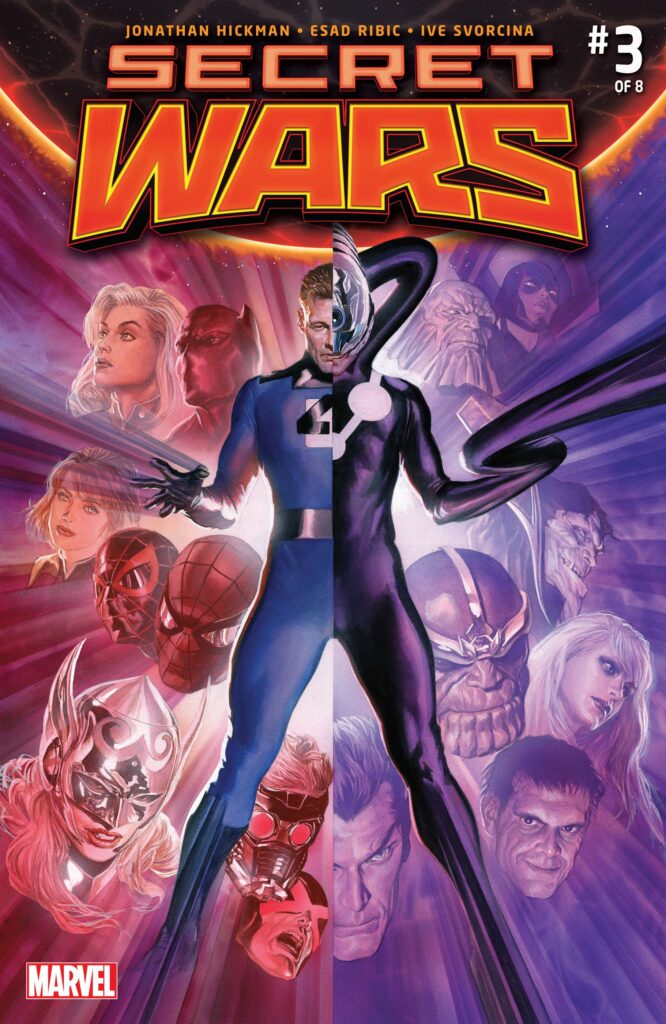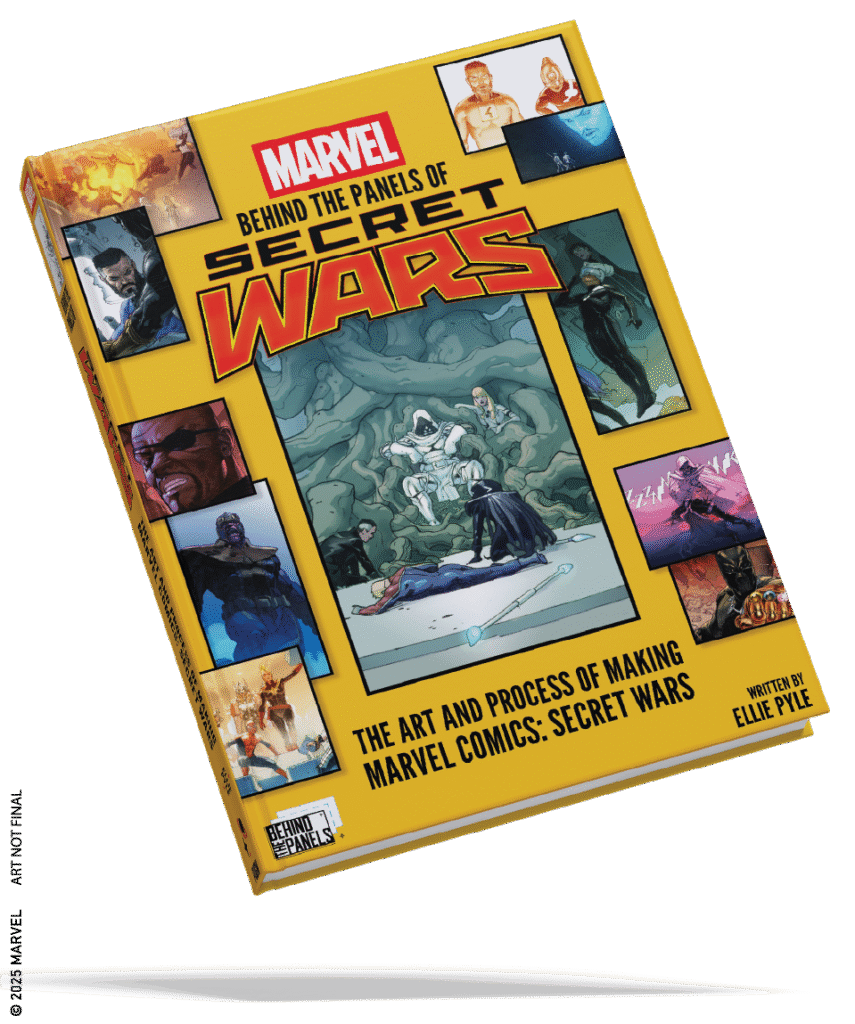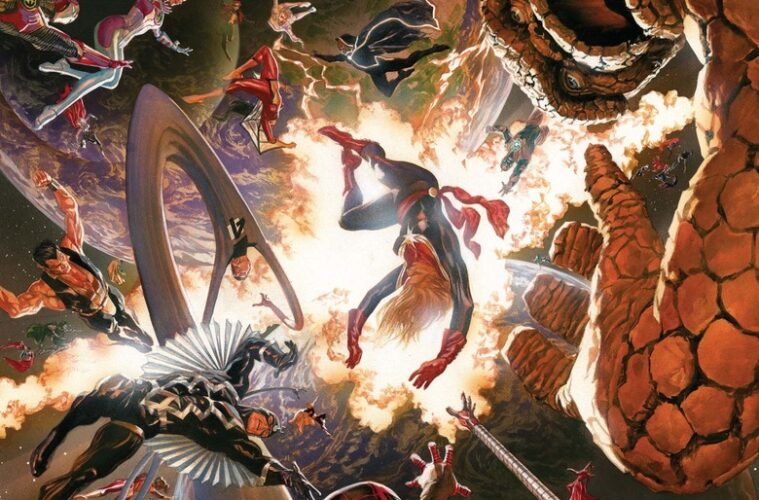Ellie Pyle knows Marvel from the inside. As a former Associate Editor during one of the company’s most ambitious creative periods, she brings a rare firsthand perspective to Secret Wars, the crossover Jonathan Hickman used to collapse and rebuild the entire multiverse. When Pan Universal Galactic Worldwide launched its new Behind the Panels series and selected Secret Wars as the opening book, Pyle was the natural choice to write it. She had been present during the early planning, followed the series as it released, and missed only the hectic middle where ideas, artwork, and editorial decisions fused into one of Marvel’s most ambitious events. This project gave her the opportunity to revisit that history with a deeper view.
Pyle approached the book not as a static archive but as a study of the creative forces behind the event. Marvel: Behind The Panels Of Secret Wars explores the writers who mapped whole realities, the editors who held the structure together, and artists like Esad Ribic who carried the visual load. Through interviews with Hickman, Ribic, Tom Brevoort, and others, she reveals how Marvel’s summits became places for bold ideas and unexpected breakthroughs.
The result is a book that captures both the scale and humanity of Secret Wars and shows why the story continues to resonate.
AAGG: You were there when Marvel’s creative engine was running hot. What made Secret Wars the story worth revisiting and re-documenting for Behind the Panels?
Pyle: Pan Universal Galactic Worldwide hired me to write this after they had already decided to start their Behind the Panels series with Secret Wars, but Secret Wars truly was the “event that was all events.” And I imagine it will be picking up a whole new generation of fans in the next few years, so it was a perfect time to revisit this massive and unusual undertaking to see how they pulled it off. This was fun for me personally, because while I was at Marvel when Secret Wars was being planned, and I read the books when they came out, I missed the part in the middle where they actually got made. And there is a lot of art and story behind the art and story.
AAGG: Secret Wars is not just another crossover. It is the Marvel Universe detonating and rebuilding itself. What was it like dissecting a story where the end of everything had to somehow make perfect sense?
Pyle: But it did all make perfect sense! And that is the magic of Jonathan Hickman, who not only built and executed this story over years, but also built mechanisms by which the entire Marvel line could participate. Marvel did not just destroy one universe. They destroyed the multiverse one universe at a time, built a new patchwork universe, and then had to break that apart and put it back together into almost the 616 we knew. This event was massive, so it was fascinating to hear about all of the planning and coordination that went into it.

AAGG: There is a mythology around those Marvel creative summits, part secret society and part caffeine-fueled chaos. What really goes down in those rooms when reality is being rewritten?
Pyle: The thing that came up over and over again as I was doing interviews for this book is how much fun the Secret Wars summits were. In particular, the summit where folks began brainstorming Battleworld was an unusual opportunity to throw out crazy ideas for books Marvel would not typically do. It was like dumping out a giant toy box and getting to just play. Not all summits are like that, especially since most crossover events do not involve the entire line or genre bending the way Secret Wars did. I did not realize at the time, as a newly minted Associate Editor, how unique some of those summits were.
AAGG: How do you keep an art book like this from feeling like a museum piece? How do you make it pulse with the same energy the comics had on release day?
Pyle: This is a book about a crossover, but it is also very much a book about the creative processes behind it. What makes Marvel characters so special is that they are people first and heroes second. So I tried throughout the book to look for the human elements that make a great Marvel story.
AAGG: Secret Wars had ripple effects that are still showing up in the MCU and beyond. How conscious were the creators that they were shaping something that would outlive the comics page?
Pyle: I think that is always a possible consideration when working on comics that are part of a pipeline into a larger media ecosystem. But the only way a story or character design makes that jump is by being memorable. So at the end of the day, creators are still just trying to make the best possible book. That said, there were a few folks who saw Secret Wars as their “swan song” from a long run at Marvel, so they were definitely trying to craft a fitting end to their own Marvel stories. Of course, Marvel stories almost never truly end, so they came back eventually.
AAGG: You are telling a story about storytelling. What did you learn about how creators handle pressure, burnout, and pure inspiration when the clock is ticking and the multiverse is collapsing?
Pyle: A lot. Deadlines are an inherent part of monthly comics. They influence not just how they are made, but sometimes the content itself. That clock never stops and the machine never stops moving. The fact that Esad Ribic drew every page of those nine mostly oversized issues is both unusual and extraordinary.
AAGG: What do you hope readers walk away with after seeing how Marvel builds worlds?
Pyle: All of the above. Whether you read Secret Wars once a year or have not read it yet but love to learn about the creative process, this book will have something for you.
End of Interview.

If Secret Wars ever blew your mind, confused you, inspired you, or made you want to pick up a pencil and dream bigger, this book is your chance to see how the whole thing came together. Ellie Pyle pulls back the curtain on the chaos, creativity, and genius that built one of Marvel’s most ambitious stories. Behind the Panels: Secret Wars is packed with insight, art, and the kind of behind-the-scenes magic fans rarely get to see.

